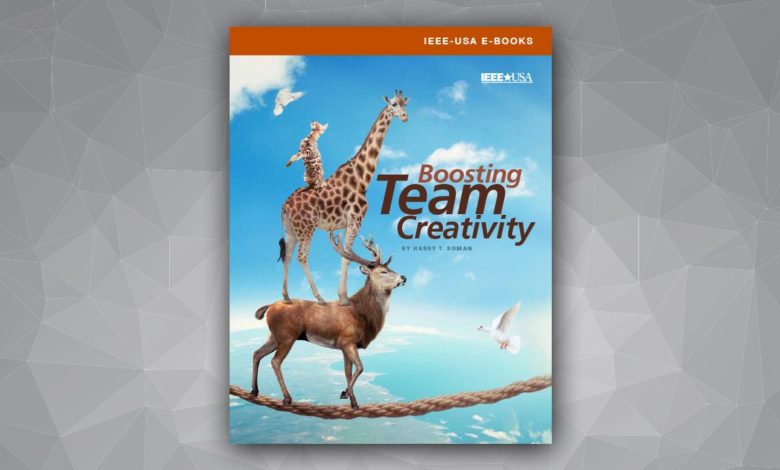
Albert Einstein once described creativity — the mental attribute of turning new and imaginative ideas into reality — as “intelligence having fun.”
But veteran engineering educator Harry T. Roman believes that when people use their imaginations and diverse perspectives to help their organization succeed, creativity is nothing less than “rocket fuel.”
In his valuable new e-book, Boosting Team Creativity, Roman writes that creativity can help a company to zoom past the competition and gain strategic advantages. Roman aims the volume at managers and team leaders, and he presents a persuasive case for why creativity is critical to an organization’s success. Then, he discusses a multitude of strategies to encourage employees’ abilities to generate ideas for problem-solving. Roman also provides helpful advice on how to regain creativity lost to email and other technological distractions.
“Creativity is important to the health and vigor of your project team and your company,” notes Roman. “Creative people can change your business, give it new perspective, re-envision it, and perhaps, even disrupt it completely.”
He says creativity should be part of the corporate DNA, used in everyday problem-solving.
Pointing to his own 36-year career in Research and Development for PSE&G, New Jersey’s largest utility, Roman writes knowingly about his professional experiences. He says that regularly interacting with diverse colleagues from all over the world — and exchanging ideas about major, longer-term issues as well as current, local work — contributed greatly to their joint successes.
“Sharing information about each other’s interests, passions, hobbies, favorite topics and leisure pursuits can spur unexpected creative thinking,” he says. “Potential friendships can also blossom.” He recommends lunches, staff meetings, off-site gatherings and social events to encourage individual team members to learn from — and about — each other.
According to Roman, the one absolute necessity that managers and team leaders must provide is what he calls “a big feeding trough.” It contains all the information that people need to keep them informed and stimulate fresh thinking. The list includes magazines, journals, transactions, and — above all — open access to the internet.
“Some companies,” he writes, “still have a stranglehold on allowing employees to access the internet freely. Such limitations serve to derail creativity. Let your employees explore things. Encourage making a creative space, and a chance to make connections between things.”
The author says oral and written communications skills also help creativity. “Good ideas are worthless, if they cannot be expressed well and correctly,” he observes.
Citing an example from his own professional experience — a team project that he led to develop mobile robots for use in hazardous environments — Roman relates how the group helped to create a national working group that eventually led other companies to join them.
“The interactions and expertise on the 23 machines we eventually launched benefitted from the team members from many companies,” he says. “We also ended up with six patents, and more than $650,000 in royalty revenue, making us a small business within the larger corporation.”
Here are some other creativity-building ideas Roman endorses:
- Encourage team members to become involved with other professional organizations,, so they can bring back worthwhile information as well as meet others working in allied fields.
- Assign each team member to teach others about a new creative technique they have researched; and then visit other companies to learn how they take raw ideas and convert them to actual products.
- Develop relationships with high school or college educators who can participate on your team, as their time permits. The educators’ experience and perspectives can become an important resource. Moreover, their enthusiastic students can bring relevant new information and ideas to the project.
Finally, the author shares his thoughts on how easily employees, teams and organizations can lose their creative edge — but also, how they can get it back again. Citing a Fast Company study, he says workers’ attention spans due to distractions diminished from three minutes in 2004, to a worrisome 59.5 seconds in 2014. Further, the study said that email and the growth of other technologically based workplace interruptions disrupts and reduces efficiency, while also taking time to refocus on the work.
Roman recommends practicing self-discipline to achieve a happy and productive flow state. He also suggests charting and recording one’s day — to understand what you are really spending time to do — as well as visualizing what needs to be done on a given day, and then doing it. He advocates breaking up tasks into smaller chunks. Roman says that as each chunk is completed, it gives the brain a neurological boost.
“Electrical activity in the brain is at a heightened flow during a productive, creative flow state,” he writes. “With the satisfaction of completion, the brain has an outpouring of serotonin, the feel-good chemical. And serotonin can spur creativity.”
An IEEE Life Senior Member, Roman holds 12 United States patents, and he has published more than 550 scientific papers, articles monographs and books. His many honors and recognitions from IEEE and other organizations for his contributions to technology education include the 2015 Region 1 Excellence in Teaching Award. He has also published more than 70 resource books, science kits, and other educational products.
Now retired, he spends many hours in the classroom working with teachers and students. He also co-teaches a graduate course at Montclair State University about applying STEM techniques in the classroom.
Boosting Team Creativity, by Harry T. Roman, is available at https://ieeeusa.org/product/boosting-team-creativity/ for $2.99 for members and $4.99 for non-members.
Helen Horwitz is an award-winning freelance writer who lives in Albuquerque, N.M. She was with IEEE from 1991 through 2011, the first nine as Staff Director, IEEE Corporate Communications.






